Tactical Doll

 Kar98k
Kar98k 

 is the poster girl of Girls' Frontline and an armed civilian Tactical Doll working for Griffin and Kryuger.
is the poster girl of Girls' Frontline and an armed civilian Tactical Doll working for Griffin and Kryuger.A Tactical Doll (人形战术), also called T-Doll, is an AI-piloted android originally designed to serve as an easily replaceable fire platform for military operations. Early generation dolls were unmistakably robots, but the standard form of Tactical Dolls came to be that of women as the need of easier human-machine interaction appeared.
After seeing heavy use in World War Three, Tactical Dolls were made available on the civilian market after the war and non-combatant dolls were made commercially available. As of 2062, most T-Dolls are manufactured by IOP and can be found in use by national armies, police forces, PMCs, security companies, civilian companies and private citizens. Griffin and Kryuger combat forces exclusively employs T-Dolls.
"Tactical Doll" refers specifically to the modern models of dedicated combat androids. Early combat dolls and unarmed civilian dolls are usually called "Autonomous Dolls" (自律人形),[1] privately employed civilian dolls can also be called Domestic Dolls (家用人形).[2]
Contents
- 1 In the game
- 2 Development and history
- 3 Technical design
- 4 Appearance and behaviour
- 5 References
In the game
List
For a detailed list, see the T-Doll Index. There are 329 Tactical Dolls as of May 27, 2020.
| Tactical Doll Archetypes | Abbreviation | Combat Notes |
|---|---|---|
| Handgun (手枪) | HG | Low resource consumption, potentially high evasion, but lack all other stats. Skills affect an entire squad (either buff friendly or debuff enemy) |
| Submachine gun (冲锋枪) | SMG | One of the two tank classes, combined very high health with high evasion, high rate of fire, below average damage and accuracy. |
| Rifle (步枪) | RF | Highest alpha damage (damage per shot), good accuracy, slowest rate of fire, lowest health and evasion. |
| Assault Rifle (突击步枪) | AR | Jack-of-all-trades, good all-around stats but excel at no specific role. |
| Machine Gun (机枪) | MG | Highest DPS (Damage Per Second), very high health, average accuracy and evasion, but require loading between short firing burst (causing no damage during loading time). |
| Shotgun (霰彈槍) | SG | The second tank class, having highest HP and having additional stat of armour, the typical meat shield with good crowd control. |
Tactical Doll Stats
- Health
 will improve from leveling up.
will improve from leveling up. - Damage
 , Evasion
, Evasion  , Accuracy
, Accuracy  & Rate of Fire
& Rate of Fire  don't directly improve by leveling up, but their maximum limits will increase and have to be upgraded manually by Powerup/Enhancement.
don't directly improve by leveling up, but their maximum limits will increase and have to be upgraded manually by Powerup/Enhancement. - Armour
 , exclusively for shotguns.
, exclusively for shotguns. - Movement Speed
 is permanent and will not change.
is permanent and will not change. - Rarity
- Rarity is identified according to the numbers of stars of each Tactical Doll.
- Tactical Dolls' rarity classifications are the following, from left to right: General -> Rare -> Epochal -> Legendary
Development and history
Skeletal-Frame Robots precursors
Public interest in robotics emerged soon after the First Beilan Island Incident as a way to replace human laborers and soldiers in the increasingly dangerous environment of Earth.[3]
The precursors to modern dolls are more accurately described as robots rather than android since production constraints gave them appearances far removed from humans. The first Skeletal-Frame Robots adapted for assembly-line production were developed by a team led by Havier Witkin from LBT General Manufacturing. They had an autonomy of 6 hours for 4 hours of recharge, were versatile and able to quickly swap their equipment to reduce maintenance time, and their AI program could be changed to adapt to a variety of jobs. This list of specification made them revolutionary at the time and required two years of tremendous work to produce the final prototype.
Experimental models were internally designated ALR-50(T) for “Auto Labor Robot (Testing)”. The first batch of production models ALR-50 took 130 man-hours to produce, which was more than the units would produce in their operational life. This hitch was quickly improved on. The ALR-50E2 could work 20-hours days, but its design was too simple to enable it to swiftly change its own equipment configuration. It was nevertheless chosen for mass production instead of its successor, the ALR-51C. The ALR-51C tried to combine operational life and effective interchangeability, but its complex design made it fall far behind the ALR-50E2 in strength tests and its flexibility tests were disappointing because no suitable AI had been developed yet. As the ALR-50E2 went into production, Witkin knew the ALR-51C could be improved into a revolutionary model with a suitable AI and more involved design, but LBT could not pour its budget into two different lines as the world situation was tensing and market was shrinking. When the ALR-52P series came to replace the ALR-50E2, even Witkin went to work on improving this model and forgot the ALR-51C.
The ALR-51C was given new life 15 months later by Westchester United Electronics Manufacturing Company's 6th development studio head, Mihacj (米哈奇). Westchester had accepted a contract from the Pan-European Alliance military to develop an autonomous system capable of using the Assault Artillery combat platform. Mihacj's team wanted to build a test platform themselves to gather initial data, but this proved extremely costly and he instead turned to external sources to buy an already existing platform to test on. This proved difficult too as the specifications needed were high for the current market, and Mihacj would have abandoned the project if he hadn't met Witkin during a mixer. Now Chief Robotics Project Supervisor, Witkin took a liking to Mihacj and pulled the necessary strings to sell the ALR-51C's blueprints and most of its databases to Westchester at low price. Two months later, Mihacj's project had adapted the operating system of the platform and made a breakthrough.
The ALR-51C was very responsive to commands and its body structure was revamped to improve its stability, making its shape closer to modern dolls. From then, it was known as the TD-01, for “Testing Doll”, and known to its designers as "Baby".[4] The TD-01 had unprecedented operational flexibility, enabling it to cover the functions of several different existing platforms and pleasing the Pan-European military, which could reduce the operational cost of its Assault Artillery vehicles and increase the command efficiency of their mechanized units. Westchester reaped the profits, and the reputation of Mihacj was boosted. Mihacj's next idea was to replace the operating system used by the TD-01 by a dedicated AI, and began a joint development with LBT and Witkin. The two friends and their teams enjoyed a considerable budget and a dedicated research building with its own machine shop and multi-terminal computing system. Six months later, the TD-01 had received a strengthened structure, a revamped software, and a small quantity of artificial muscle fibers to test their power output. This model was called the CSD-02, for “Common Strength Doll”, and went through a rapid testing-iteration process, Mihacj's AI developers using the constant influx of data to tweak its processes. The CSD-02 was becoming an effective AI-piloted platform, but the structural complexity was still a problem. Witkin unenthusiastically searched for inspiration in the ALR-52P's design to try and reduce part count.[5]
In parallel to the internal development of the CSD-02, other companies like Scheppel Advanced Technology Co. sought to purchase IP rights to the platform to adapt it to their own purposes. Scheppel had become interested in the CSD-02 from AI experimental reports in order to fulfill a military contract. The military had troubles getting test data from its Assault Artillery systems because of the high casualty rates from its manned operators, and their main partner Westchester had already shifted its attention to AI systems when the problem arose. Scheppel filled this void to provide the military a doll capable of using Assault Artillery systems, with increased load capacity and force sensors in critical joints for easy data collection, and delivered the platform in 2041. Dolls equipped with this sensor package were designated CSD-03H, and their sensors system was reused in later models to improve agility and movement precision.
The quick progress in the field of dolls pushed the Pan-European Alliance to ask Westchester and Scheppel to collaborate on creating a completely combat-capable Tactical Doll system in order to replace the waning numbers of their armies. The Chief of Staff General Carter was the main proponent of this project and managed to secure funds and assemble an internal commission to ensure the two companies would cooperate. Westchester and Scheppel both invested capital in forming a new company dedicated to military combat doll applications, called Important Operations Prototype Manufacturing Company, or IOP.[5]
First Generation Tactical Dolls
It took three years from planning to official founding to found IOP. During this time, Witkin sensed the dolls market could go beyond military organizations and spent time finding partners to solve the incoming technical challenges of advanced doll systems and raise interest in the civilian and security markets. Witkin registered three wholly-owned subsidiaries in the US, Ukraine and China to find local partners. The Ukraine branch entered a partnership with the rapidly growing Sangvis Ferri Manufacturing, who were more interested in the toughness of the ALR-52P than the advanced technologies of the CSD-03H and invested large amounts of money in IOP while also offering to provide AI researchers.
The start of World War Three in 2045 forced Witkin to accelerate its plans to begin taking the fast-coming military contracts, and IOP was founded in 2046. Sangvis Ferri became an important partner as production demand became higher and higher, and IOP subcontracted part of its production to SF and provided them technical documents to modify the Tactical Dolls. The modified ALR-52P Jaegers produced by SF became widely used on the frontlines as the CSD series was falling out of favor because its autonomy and frequent malfunctions due to its complexity made it unreliable on the battlefield, and they were relegated to gun platforms used by the military police and derided as target practice by frontline personnel. IOP lost contracts to SF, which enraged Witkin and the relations between the two companies soured. Witkin nevertheless pushed for versatile Tactical Dolls and worked to improve the AI and reliability of the CSD series, but didn't get satisfying results, demoralizing IOP's teams.
In 2049, Mihacj discovered from one of his students articles about an underground research group called 90wish. Witkin was impressed by the technological capacities and development drive of the group and tried to contact them, but the group seemed completely inaccessible. Witkin learned from the Russian Internal Internet Security Bureau that 90wish was in an internal debacle, as all its members had not approved going public. Through a contact in the Ministry of Internal Affairs, Witkin learned of two former 90wish members whose lives were threatened by their former comrades: Persicaria and Lycoris. Witkin hired a PMC to escort them to IOP's buildings, which succeeded though the PMC soldiers suffered casualties.[6] The Ministry of Internal Affairs was also involved in the mission to secure Persicaria.[7] Both scientists agreed to work for IOP under false identities as members of a company called Hermit, contracting with IOP.[6] Hermit's work included Lycoris' tree-shaped command system based on his AI prototype Elisa, which enabled great direct command efficiency and was advantageous to implement a variety of algorithms and encryption modes.[7] Lycoris and Persicaria enabled several breakthrough in the CSD series' development, leading to the CSD-08A and CSD-08B models, the experimental IAD series and the production ACD series, regaining the favors of military clients for their reliability, resilience and capacity to be used both on frontlines and as manual laborers.
The ACD series were deployed in the Nordic campaigns and used as sentinels instead of frontline fighters due to their lacking AI. IOP had sacrificed flexibility in favor of fewer part count and structural stability and added layers of armor, increased the density of the titanium alloy used in the framework to make Tactical Dolls more resilient. They made a smaller head unit to reduce their target surface and encased the camera unit in 10mm steel plates. Visual control and guidance modules were relocated in the armored thorax and relied on waveguides rather than physical cables. Interface ports in the neck and lower spine allowed an operator to take control if the AI system was lost. The ACD-50 had a scanning radius of 220m, could function in action for 28 hours on full charge or 55 hours on standby and was cheap to buy and maintain. The ACD-51 entered production in 2051, during the last year of the war, and lowered the center of gravity to make using heavy weaponry more reliable, expanded internal storage and load capacities to solve ammo supplies problems, but reduced the scanning range to a radius of 200 meters and the autonomy to 21 hours in action or 48 hours on standby. These downgrades were of no consequence for the military clients compared to the improvements. The additional R and T series were reconnaissance and special operations models produced in small quantities.
The ACD-series Tactical Dolls were the most used during World War Three, with 11 730 units produced, including 2300 by Sangvis Ferri. [6]
Second Generation Tactical Dolls
The civilian dolls market grew after the end of World War Three as the production, service and PMC sectors were short in manpower. IOP enjoyed a comfortable market share thanks to its relations with major PMCs and international industrial companies. A major client of IOP was Griffin and Kryuger (G&K), who preferred to rely on cheaper armed civilian Tactical Dolls rather than human mercenaries. G&K was also given a direct feedback channel to Hermit, enabling Persicaria to improve the CSD-06, CSD-07 and CSD-08 series, develop the SST-02A and SST-03 models and develop the Service Dolls series dedicated to civilian markets, with emotional simulation software and gendered appearances, and later improve man-machine interaction with attractive appearances and customization capabilities. Receiving contracts from governments, business companies, civilian services companies and private individuals, IOP's revenues boomed.
By 2054, Persicaria had completed her Etching Theory and laid the groundwork for adapting 90wish's Zener Protocol to T-Dolls.[3] The result was the concept of Second Generation T-Doll,[7] using a modular chassis based on the prototype from the earlier IAD series.[6] Witkin supported the continuous improvement of T-Dolls, but refused to add funds to Lycoris' autonomous AI research. This frustrated Lycoris, who decided to join Sangvis Ferri. SF hired G&K to escort Lycoris to their underground research labs, with his subsequent research results as payment. Lycoris' defection led to Witkin increasing even more Persicaria's funding, and in 2057 she founded 16Lab, a first-party manufacturer of IOP.[7] The same year,[3] 16Lab improved the Zener Protocol into the Dummy Network system, introducing a differentiation between mainframe dolls with complete software and hardware capabilities, and dummy dolls with reduced functions. While this increased the cost of mainframes, it lowered the cost of dummies and made the overall price of a dummied team lower. This created a serious price advantage for IOP.[7] A year later in 2058, Persicaria finalized her personal project:[3] Imprint Technology, enabling T-Dolls to use already existing firearms. Imprint Technology was open-source, but 16Lab's proficiency over its inner workings resulted in IOP dolls still having the advantage in the market.[7] After World War Three, high grade weaponry was supplied exclusively to military units and banned from civilian market. PMCs such as Griffin and Kryuger instead used outdated weapons ranging from the late 19th century to the 2010s.[8]
All IOP dolls included Imprint softwares and Dummy Networking as a standard, and were sold in modular packages, finalizing the specifications for the Second Generation T-Dolls envisioned by Persicaria. She published the technical specifications, hoping other companies would follow them to unify all dolls control systems and production standards on the market.[7] In 2060, on G&K's request, IOP purchased the Neural Cloud recording system, reducing data losses during operations.[3]
Over at Sangvis Ferri, in late 2054, Lycoris installed Elisa as the mainframe for computing human orders and relaying it to T-Dolls, making orders management extremely efficient though SF dolls were expensive to produce and Elisa suffered from lapses of consciousness Lycoris still needed to resolve. As SF established a new Dolls manufacturing plant in a dangerous but resources-rich area,[3] Lycoris exploited their robust manufacturing capabilities to eschew software compatibility with a wide range of firearms and develop miniaturized particle weapons and mount them on dolls, then testing the results and iterating. Individual SF dolls had better performance as a result and their capabilities was more unified.[7] On G&K's suggestion, the Dummy Network technology was presented to Lycoris but he showed no interest, too engrossed in his AI research.[3] When Sangvis Ferri disappeared as a manufacturer after the Butterfly Incident of 2061, all their work was lost in Area S09 and IOP basically controlled the Tactical Doll market, be it military dolls, armed civilian dolls or unarmed civilian dolls. Persicaria further developed the modularity and safety of T-Dolls by implementing the Fire Control Core concept.
The goal of IOP to standardize tactical and civilian dolls design was reached after 2062. IOP regrouped military dolls into the ACD series, while creating six civilian models grouped into the SST and SSD series.
The SST series had good processor speed, high weapon compatibility and a lot of memory dedicated to human-machine interaction and emotions simulation. Their flagship product, the SST-05, was based on an early special warfare model and had lower specs than other models, but were widely available and had large digimind databases, meaning a lot of combat data was readily available to make dolls immediately efficient. The SST-05A, the most used model in G&K's frontline troops, was an upgrade compatible with the SST-05's combat data, with lesser software requirements and better hardware performance. The SST-05A2 was a custom-made special warfare model with performances close to military dolls and independently encrypted storage to make them safe to use on black operations, but costly and with limited storage dedicated to emotional simulation in favor of other specialized software.
The SSD series was intended to cover both the civilian and tactical market, with a large memory space dedicated to emotional simulation and third party interaction systems easily costumizable by civilians and hundreds of appearance modules on the market, while still being compatible with Fire Control Cores for security and police applications. The SSD-62D was intended for the service industry and the SSD-62F for ceremonial purposes. The SSD-62G is intended for secret service duties as an intermediate level between police and military dolls, they are more expensive and less available, but very performant as they are customized for specific tasks.[7]
Later improvements
After the Butterfly Incident, Griffin and Kryuger captured a Sangvis Ferri SPzH3000 Tactical Doll Architect after she surrendered. Her weaponry was studied by 16Lab and the ASST system was upgraded with Sangvis Ferri heavy weaponry operation technology, creating T-Dolls groups capable of operating weapons such as mortars and anti-tank shells launchers, dubbed Heavy Ordnance Corps (HOC).[9] HOCs teams integrate a spotter, a weapon operator, a weapon loader and sometimes a guard. The need for multiple T-Dolls acting as a unit may be because they are civilian T-Dolls of lower physical capabilites compared to Sangvis Ferri T-Dolls.
In 2094, during the First Antarctic War, the Union of Rossartrism Nations Coalition used the Bear's Den secret site to mass-produce clones of Noel and Jefuty, subjects of the Three Goddesses project, intending to include their DNA in next generations of Tactical Dolls. The clones were destroyed during operation Kindle.[10]
Technical design
Orders management
Most T-Dolls, even those designated as echelon commanders, require direct human orders to operate even if they can process their immediate tactical situation,[11][12] but they can receive varying degrees of liberty. Commanders can give T-Dolls standing orders, or outfit them with preset stratagems so they can perform automated actions.[13]
Due to root instructions in their Digimind, T-Dolls will suffer structural damage to their Digimind if they actively refuse a human order, act counter to orders or try to harm a human without authorization.[14] T-Dolls may be authorized to harm humans under set circumstances.[15] T-Dolls can teach a human how to command T-Doll echelons in emergency situations.[16]
Command Protocol
A command protocol is a time-limited authority a T-Doll can receive to lead a team. A command protocol has been used in cyberspace to create simulated echelons.[17]
List of known dolls with/once had/speculated having command protocols:
- RF DSR-50
 DSR-50
DSR-50 


 (Her unit's involvement during operation Deep Dive, also her being able to operate alone to fulfill her end of the deal struck with UMP45)
(Her unit's involvement during operation Deep Dive, also her being able to operate alone to fulfill her end of the deal struck with UMP45) - AR K2
 K2
K2 


 (K2 was given command protocol and a squadron to guard a city ruin)
(K2 was given command protocol and a squadron to guard a city ruin) - AR OTs-14
 OTs-14
OTs-14 


 (OTs-14 Groza leads a squadron of T-Dolls of Russian origin, she is speculated as having command protocol)
(OTs-14 Groza leads a squadron of T-Dolls of Russian origin, she is speculated as having command protocol) - RF IWS 2000
 IWS 2000
IWS 2000 


 (IWS leads a squadron of T-Dolls of Austrian origin, her squadron operated in cooperation with other T-doll echelons during chapter 8 night, she is speculated as having command protocol)
(IWS leads a squadron of T-Dolls of Austrian origin, her squadron operated in cooperation with other T-doll echelons during chapter 8 night, she is speculated as having command protocol) - HG Welrod
 Welrod
Welrod 


 (Welrod leads a squadron of T-Dolls of British origin, her squadron took part in the operations during chapter 8 night assisted IWS' squadron, she is speculated as having command protocol)
(Welrod leads a squadron of T-Dolls of British origin, her squadron took part in the operations during chapter 8 night assisted IWS' squadron, she is speculated as having command protocol)
Command Module
Some T-Dolls are outfitted with a command module, which let them take decisions related to their main objectives and operate independently for short amounts of time.[1] The AR Team could operate as a task force with AR M4A1 M4A1
M4A1 
![]()

 's highly-efficient command module,[18] and later with SMG RO635
's highly-efficient command module,[18] and later with SMG RO635 RO635
RO635 
![]()

 's basic command module.[19] Command modules are resource-intensive and T-Dolls not designed primarily to use them will experience fatigue after using them for long periods of time.[20][21]
's basic command module.[19] Command modules are resource-intensive and T-Dolls not designed primarily to use them will experience fatigue after using them for long periods of time.[20][21]
List of known dolls with/once had command module installed:
- HG Five-seveN
 Five-seveN
Five-seveN 


 (57 commented on her installed command module when she overtook the command of PP-90's garrison during event Hitoribocchi)
(57 commented on her installed command module when she overtook the command of PP-90's garrison during event Hitoribocchi) - AR M4A1
 M4A1
M4A1 


 (Leader of AR Team, M4A1 is the first T-Doll with the command module installed known to the newly arrived G&K Commander)
(Leader of AR Team, M4A1 is the first T-Doll with the command module installed known to the newly arrived G&K Commander) - SMG RO635
 RO635
RO635 


 (RO635's command module was further developed based on combat data fed back from AR Team, later on fine-tuned by commanding Palette Squadron, RO's command module is speculated to be the most advanced version to date)
(RO635's command module was further developed based on combat data fed back from AR Team, later on fine-tuned by commanding Palette Squadron, RO's command module is speculated to be the most advanced version to date) - AR AK-12
 AK-12
AK-12 


 (As observed during Singularity and Continuum Turbulence campaign)
(As observed during Singularity and Continuum Turbulence campaign)
AI delegation
Sangvis Ferri Dolls take orders from the relay mainframe AI Elisa, with orders trickling down the chain of command from Elisa to high-rank Ringleaders, then to lower-rank Ringleaders and finally to standard units.[1]
Exceptions
SMG UMP45 UMP45
UMP45 
![]()

 was able to delegate her command authority to another T-Doll, SMG UMP40
was able to delegate her command authority to another T-Doll, SMG UMP40 UMP40
UMP40 
![]()

 , to receive commands from her instead of a human commander.[22] When UMP40 died, UMP45 was free to take her own decisions instead of entering stand by mode. The origins of this unique amount of freedom has yet to be explained, it may be because UMP40's last wishes for her freedom were registered as valid orders, because of her origins as Sangvis Ferri T-Doll or because she was modified to cause the Butterfly Incident.
, to receive commands from her instead of a human commander.[22] When UMP40 died, UMP45 was free to take her own decisions instead of entering stand by mode. The origins of this unique amount of freedom has yet to be explained, it may be because UMP40's last wishes for her freedom were registered as valid orders, because of her origins as Sangvis Ferri T-Doll or because she was modified to cause the Butterfly Incident.
Squad 404 uses the quivalent of a command module containing the data of a commander to simulate human orders and act with total independence. This module is usually held by SMG UMP45 UMP45
UMP45 
![]()

 but has also been used by SMG UMP9
but has also been used by SMG UMP9 UMP9
UMP9 
![]()

 ,[23] though only UMP45 can use it for long periods of time.[21] It has been suggested that AR HK416
,[23] though only UMP45 can use it for long periods of time.[21] It has been suggested that AR HK416 HK416
HK416 
![]()

 could also use it.[24]
could also use it.[24]
Imprint Technology (ASST)
Imprint Technology (烙印技术, sometimes translated "Branding" by fans), officially called "ASST" for Advance Statistic Session Tool[Source needed], is a software relying on compiled code to improve the proficiency of a T-Doll with specific tools and weapons,[7] providing them an "instinctual" feel of how to best employ it.[1] Some Dolls study the history of their weapon of choice to feel like they can achieve higher affinity and greater efficiency.[25] It's an implementation of Etching Theory (蚀刻理论), a general concept to let two objects form a standalone connection.[1] As an open-source technology, anybody can download the base ASST engine and customize their doll's operational program.
Imprint Technology was made public in 2057 by 16Lab, who maintained and updated ASST in the long-term. Since 16Lab is a first-party manufacturer for IOP, IOP brand T-Dolls are the most effective when used with Imprint Technology.[7]
Zener Protocol
The Zener Protocol (齐纳协议) is a wide area communication protocol built by 90wish[1] and later modified by 16Lab in a doll operation network interface.[7] Similar to Peer-to-Peer technology, it enables a team of dolls to transmit messages to each others without relying on a mainframe or satellite uplink[1] so they can relay human orders and new tactical information. This enables a group of Dolls to function independently without a human command to an extent.[7]
OGAS Protocol
Derived from the large-scale Soviet OGAS system, the OGAS command protocol is used by Sangvis Ferri T-Dolls instead of the Zener Protocol.[26] Due to the fundamental differences between Zener and OGAS (one being mash-based and the other tree-based), it is difficult for an IOP T-Doll to disguise herself as a Sangvis T-Doll,[27] though not impossible.[28] Old DSI-8 models Sangvis T-Dolls like SMG UMP40 UMP40
UMP40 
![]()

 and SMG UMP45
and SMG UMP45 UMP45
UMP45 
![]()

 can swap their operating system between Zener and OGAS.[29][30]
can swap their operating system between Zener and OGAS.[29][30]
Dummy Network
A special application of the Zener Protocol, Dummy Networking (傀儡网络) is a command network protocol enabling a human command to be received by one doll, who would analyze and relay the command to the rest of its group. A team of dummied dolls functions about 37% more efficiently than a team relying only on Zener Protocol connection.
The protocol was optimized by separating dolls in "mainframes" and "dummies", with only the mainframes having the processor and synchronization software necessary to compute commands. Dummies are cheaper since they only carry imprint, scouting and combat software with minimal hardware functions. As a result, the total price of a dummied squad is lower than a squad of standard dolls.[7]
One can speculate on what would happen if a mainframe was destroyed before its dummies. Either they would simply collapse when the link is severed, or they could host a backup of the mainframe's Neural Cloud, and continue to operate at lower capacity due to inferior specifications.
Fire Control Core
A later development by 16Lab, the Fire Control Core (FCC) contains all combat-related software in a physically removable module, making it easy to take away a T-Doll's combat capabilities. The FCC has a number of interface ports to make it fully compatible with any modification of Imprint software.[7] Fire Control Cores takes up set bandwidths within a T-Doll's operating system, operators can choose to fit lower grade Fire Control Cores to reserve space for other items such as E-War modules.[31]
Neural Cloud
Neural Cloud (心智云图), sometimes referred to as Digimind, is the AI system serving as the mind of T-Dolls. It can be compared to their operating system. Neural Cloud is a proprietary recording system having the advantage to be transferable to and from a mainframe to protect a T-Doll's memories from being lost if they are destroyed during operations.[3] The doll's memory can then be downloaded into a new body.[1] Regular periods of "sleep" are necessary for T-Dolls to clear their memory cache[32][20] but most, standard T-Dolls are not able to dream.[33]
There are three consciousness levels for a neural cloud. Level I, or “surface consciousness”,[34] is the default state of awareness. Level II is equivalent to a state of sleep or deep trance where a T-Doll's body freezes in a position and she stops responding to external stimuli. T-Dolls are taken to this level during maintenance[35] or when performing a level of electronic warfare (EW) where they need to cut control on their body and external sensors to save processing power.[26] A T-Doll can usually enter and leave Level II at will but some EW attacks can leave a T-Doll's neural cloud stuck at Level II until repaired.[36] Level III is equivalent to a T-Doll's subconscious and is reached during heavy maintenance when a T-Doll's control on her body is completely severed and she can't wake up without external assistance.[24]
The neural cloud is contained in a dedicated module of a T-Doll's body called the neural core. This core possess its own power bank to keep the neural cloud safe for a period of time when it is taken out of the body. Under normal circumstances, extracting the neural core is probably done with specialized tools, but it is also possible to extract it more violently by ripping the T-Doll's body open. However, a neural core is a fragile piece of hardware that is easily damaged.[37] It is still possible to recover some data if a neural core has been damaged or ran out of power.[38]
Human behavior modules
Griffin and Kryuger T-Dolls retain their Emotions Module, which some T-Dolls consider unnecessary because it also enables them to feel various forms of stress.[39] T-Dolls systems emulates physical pain as a self-preservation incentive[40] and heavy breathing is replicated to provide air cooling for internal components during intense activities.[41] They are also equipped with a biological reactions modules to emulate functions of the human body like sneezes, which can be turned off during operations.[42]
Unnecessary but human-like behaviours in T-Dolls are important to reduce the uncanny valley effect when they interact with humans for extended periods of time. AR HK416 HK416
HK416 
![]()

 explained that she ate food to this effect during her time under military service, when she needed to work with humans in high stress environment.[43]
explained that she ate food to this effect during her time under military service, when she needed to work with humans in high stress environment.[43]
Electronic warfare module
Most T-Dolls can run electronic warfare (EW) tasks, such as hacking into a system or performing counter-hacking at a basic level, but they can't draw much of their computing power for these operations. A dedicated module is necessary for serious EW operations. Electronic warfare directly puts the integrity of the neural cloud at risk in case of countermeasures.
List of known dolls with/once had EW module installed or are stated to be experienced with EW:
List of dolls who have participated in EW despite lack of module/inexperience:
- MG AEK-999
 AEK-999
AEK-999 


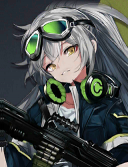
- HG M950A
 M950A
M950A 



- HG Thunder
 Thunder
Thunder 



- AR K2
 K2
K2 



- SMG TMP
 TMP
TMP 



- AR G11
 G11
G11 


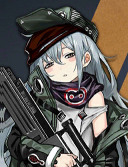
- AR HK416
 HK416
HK416 



List of dolls stated to have no EW module:
- HG Welrod
 Welrod
Welrod 



Energy System
T-Dolls have primary and emergency power banks and can share their power with external equipment if necessary.[44] The neural core housing a T-Doll's neural cloud has its own power banks to keep it functional for a period of time even after it has been disconnected from any power source.[45]
T-Dolls can also consume food to generate energy and may enjoy eating,[46] but the conversion efficiency to usable power is low, which is why food is not usually used outside of emergency situation.[43] Efficient but unpalatable MREs can be used, but some T-Dolls have their own tastes in cuisine.[Source needed] AR M4 SOPMOD II M4 SOPMOD II
M4 SOPMOD II 
![]()

 , a long-range tracking specialist with long operational efficiency, was able to operate in combat situation without recharging for about 24 hours straight[47] while the command-type T-Doll SMG RO635
, a long-range tracking specialist with long operational efficiency, was able to operate in combat situation without recharging for about 24 hours straight[47] while the command-type T-Doll SMG RO635 RO635
RO635 
![]()

 could complete a recharge plus cache clearing cycle in about one hour.[48]
could complete a recharge plus cache clearing cycle in about one hour.[48]
Retirement
The privileged relationship between IOP and G&K meant that IOP was willing to take dolls back from them to retire them from combat. These dolls were those who had no more use at G&K, or were found abandoned on the battlefield and brought back. IOP demilitarizes these dolls by taking their Fire Control Core away, before tweaking them and releasing them on the civilian market.[1][49] They usually end up as waitress or mine workers.[50]
Elite T-Dolls
Despite a lot of T-Dolls' comment on their outstanding performances and high rated status, only a few T-Dolls can truly be classified as Elite T-Dolls. Some elite T-Dolls are not converted from civilian service dolls, they are likely built purely for war and never given a job within the human society, meaning they have very little experience in interacting with humans other than receiving orders. Also likely due to the expense, elite T-Dolls are not manufactured in great numbers, some are likely to be the only one of their kind.
Capable of solo operation, excels at covert activities and electronic warfare, it could be argued that members of Squad 404 can also be classified as elite T-Dolls despite being a rogue faction.
AR Team
Produced by the top ranking research division within I.O.P., AR Team members are all produced and fine-tuned to optimal combat performance by 16LAB lead by Persica, their solo operation capability renders them as elite T-Dolls. On top of being able to receive commands, and operate without a human commander, each members of AR Team are even capable of operating individually without any commands.
AK-12 and AN-94
Both original members of Task Force DEFY were built to meet the specifications of National Security Bureau, both AR AK-12 AK-12
AK-12 
![]()

 and AR AN-94
and AR AN-94 AN-94
AN-94 
![]()

 demonstrates superior combat performance as T-Dolls. In addition to physical combat, they also excel at electronic warfare, both are capable of rapid database hacking and infiltration, AK-12 is even able to subjugate unmanned military androids and use them as additional combat force. AN-94 can also subjugate abandoned units but cannot use them as combat force, only as additional processing units.
demonstrates superior combat performance as T-Dolls. In addition to physical combat, they also excel at electronic warfare, both are capable of rapid database hacking and infiltration, AK-12 is even able to subjugate unmanned military androids and use them as additional combat force. AN-94 can also subjugate abandoned units but cannot use them as combat force, only as additional processing units.
Other known elite T-Dolls
- SG M1887
 M1887
M1887 


 is likely an elite T-Doll, since she was chosen to operate alone atop the snowy mountain during the event of Arctic Warfare until her meeting with the AR Team.
is likely an elite T-Doll, since she was chosen to operate alone atop the snowy mountain during the event of Arctic Warfare until her meeting with the AR Team. - RF DSR-50
 DSR-50
DSR-50 


 was recognized as an elite T-Doll by SMG UMP45
was recognized as an elite T-Doll by SMG UMP45 UMP45
UMP45 


 during Deep Dive. She commented that by unleashing DSR-50, they could easily defeat the rampaging Garm unit.
during Deep Dive. She commented that by unleashing DSR-50, they could easily defeat the rampaging Garm unit. - RF M82A1
 M82A1
M82A1 


 and SG M870
and SG M870 M870
M870 


 are both classified as elite T-Dolls during Continuum Turbulence, but their existence was kept a secret due to their behaviour and personality.
are both classified as elite T-Dolls during Continuum Turbulence, but their existence was kept a secret due to their behaviour and personality. - AR Type 97
 Type 97
Type 97 


 is called an elite by other T-Dolls during Bounty Feast.[51]
is called an elite by other T-Dolls during Bounty Feast.[51] - Before joining Squad 404, AR HK416
 HK416
HK416 


 was an elite T-Doll in G&K, but only a few T-Dolls remembered her exploits by 2062.
was an elite T-Doll in G&K, but only a few T-Dolls remembered her exploits by 2062.
Appearance and behaviour
Prior to enlisting, T-Dolls serving in Griffin and Kryuger worked various professions within the society, SMG AK-74U AK-74U
AK-74U 
![]()

 worked in retail prior to G&K service,[52] RF SRS
worked in retail prior to G&K service,[52] RF SRS SRS
SRS 
![]()

 and RF T-CMS
and RF T-CMS T-CMS
T-CMS 
![]()

 were likely part of an education profession, SG RMB-93
were likely part of an education profession, SG RMB-93 RMB-93
RMB-93 
![]()

 was likely an office worker, while SG S.A.T.8
was likely an office worker, while SG S.A.T.8 S.A.T.8
S.A.T.8 
![]()

 had the longest known service record, worked as a part timer from convenience stores, to luxury hotels, to animal breeders and then in child nursery programs.[Source needed] Service dolls are considered docile and obedient.
had the longest known service record, worked as a part timer from convenience stores, to luxury hotels, to animal breeders and then in child nursery programs.[Source needed] Service dolls are considered docile and obedient.
Different dolls have different exterior appearance, where most takes the appearance of human females around the age 13 to 17, with a few models appear significantly more senior than the others, while some are more junior. HG Python Python
Python 
![]()

 and RF PTRD
and RF PTRD PTRD
PTRD 
![]()

 are examples of senior T-Dolls while HG Colt Revolver
are examples of senior T-Dolls while HG Colt Revolver Colt Revolver
Colt Revolver 
![]()

 and SMG MP5
and SMG MP5 MP5
MP5 
![]()

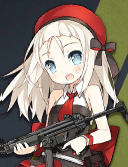 are considered younger in appearance. Doll clothing and fashion of choice varies with their personality, being similarly shaped to humans, they have complete compatibility with clothing designed for humans,[53] Dolls can purchase their clothing of desire on their own or wear any employer issued uniforms.[Source needed] Some T-Dolls retain scars from previous damage on their bodies like SMG UMP45
are considered younger in appearance. Doll clothing and fashion of choice varies with their personality, being similarly shaped to humans, they have complete compatibility with clothing designed for humans,[53] Dolls can purchase their clothing of desire on their own or wear any employer issued uniforms.[Source needed] Some T-Dolls retain scars from previous damage on their bodies like SMG UMP45 UMP45
UMP45 
![]()

 , AR M16A1
, AR M16A1 M16A1
M16A1 
![]()

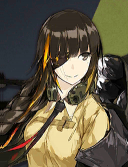 and HG Thunder
and HG Thunder Thunder
Thunder 
![]()

 . Most T-Dolls only seem to have clean cuts when wounded but some like AR AN-94
. Most T-Dolls only seem to have clean cuts when wounded but some like AR AN-94 AN-94
AN-94 
![]()

 , AR EM-2
, AR EM-2 EM-2
EM-2 
![]()

 and RF KSVK
and RF KSVK KSVK
KSVK 
![]()

 have been shown bleeding, even though SMG UMP45
have been shown bleeding, even though SMG UMP45 UMP45
UMP45 
![]()

 's clothes were not stained when she lost her right arm to a tank shell.
's clothes were not stained when she lost her right arm to a tank shell.
Dolls come with different personality settings and hobbies, which are factory set[54] and usually cannot be overwritten.[55] There are exceptional cases where after a series of events and/or newly installed modules, T-Dolls became more aggressive and vengeful.[56]
Doll hobbies varies greatly between dolls:
- Some hobbies are collection based, such as RF SV-98
 SV-98
SV-98 


 's badge collection[57], RF SVD
's badge collection[57], RF SVD SVD
SVD 


 's sticker collection[57] and AR M4 SOPMOD II
's sticker collection[57] and AR M4 SOPMOD II M4 SOPMOD II
M4 SOPMOD II 


 's Sangvis Ferri android body parts collection.[52][58]
's Sangvis Ferri android body parts collection.[52][58] - Some hobbies are activity based, such as AR TAR-21
 TAR-21
TAR-21 


 's interest in tea ceremony, flower arranging, kendo and ballet[59], SMG Sten MkII
's interest in tea ceremony, flower arranging, kendo and ballet[59], SMG Sten MkII Sten MkII
Sten MkII 


 's baking hobby[59] and SMG TMP
's baking hobby[59] and SMG TMP TMP
TMP 


 's interest in computing electronics.[60]
's interest in computing electronics.[60] - Other hobbies are consumption based, such as AR FNC
 FNC
FNC 


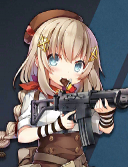 's love for sweets and chocolates,[52] AR A-91
's love for sweets and chocolates,[52] AR A-91 A-91
A-91 


 's excessive vodka consumption,[52] and AR T91
's excessive vodka consumption,[52] and AR T91 T91
T91 


 's obsession with milk tea.[59]
's obsession with milk tea.[59]
Much like ordinary humans, dolls can gain experience in combat, the longer they spend in sorties the better bonded they are with their weapon, on top of tactical knowledge, thus making them more effective at combat. This is why preserving their Neural Cloud is important.
I.O.P. is capable of producing T-Dolls merely from data description of a human, achieving pinpoint precision on all exterior features and flawlessly mimicking the personality. Every member of Schicksal Valkyrja had their data collected by I.O.P. and T-Dolls flawlessly resembling themselves were left behind when they departed from the world.[62]
T-Dolls hardware is not affected by air temperature and can function in subzero environments,[43] though their joints can freeze in snow storms and their weapons are not as resilient to extreme temperatures.[63][64] T-Dolls can't normally remain immersed in water for long periods of time without specific equipment as their body is not entirely waterproof and water would seep in and they would short-circuit after a period of time.[65] T-Dolls are shown to be able to immerse for short periods of time with no danger (aside from not knowing how to swim) during the Far Side of the Sea event, and rain appears to not be dangerous either.[66] T-Dolls with aquatic themes like HG SPP-1 SPP-1
SPP-1 
![]()

 and AR ADS
and AR ADS ADS
ADS 
![]()

 are probably purpose-built with better waterproofing.
are probably purpose-built with better waterproofing.
Prosthetic limbs
Most T-Dolls designs in game have normal human like limbs, there are a few however with mechanical limbs instead of normal human-like limbs, most of the designs are left to artists' discretion and some are explained in story. Earliest examples of dolls with mechanical limbs are AR M4 SOPMOD II M4 SOPMOD II
M4 SOPMOD II 
![]()

 and AR G41
and AR G41 G41
G41 
![]()

 :
:
- SOPMOD II's mechanical limbs in fact of Sangvis Ferri design. Yo demonstrate the modularity of the rifle she represents, SOPMOD II is able to use body parts of other manufacturing origin, certain point in the story she demonstrated the ability repair herself with available spare parts from a field of battle.
- G41 on the other hand never had any form of story explanation to her mechanical limbs, artist NS also did not comment on the design. Though however G41's costume Beach Punk 2064 revealed her with actual human-like arms.
Artist 小吃 (Chichi) who got introduced to the game's contributing roster after producing HG CZ52 CZ52
CZ52 
![]()

 is very keen on drawing mechanized legs, evident from CZ52 and Chichi's latest doll AR ADS
is very keen on drawing mechanized legs, evident from CZ52 and Chichi's latest doll AR ADS ADS
ADS 
![]()

 . While either MICA story team nor the game lore had made any comments on the exact structure of a T-Doll, Chichi boldly commented on ADS' character design sheet she posted on Twitter, introducing the concept of 'synthetic flesh' over T-Doll's body. Since this wasn't mentioned by MICA Team's story team, the concept of 'synthetic flesh' shouldn't be considered canon for now.
. While either MICA story team nor the game lore had made any comments on the exact structure of a T-Doll, Chichi boldly commented on ADS' character design sheet she posted on Twitter, introducing the concept of 'synthetic flesh' over T-Doll's body. Since this wasn't mentioned by MICA Team's story team, the concept of 'synthetic flesh' shouldn't be considered canon for now.
References
- ↑ 1.0 1.1 1.2 1.3 1.4 1.5 1.6 1.7 1.8 The Art of Girls' Frontline Vol.1, Glossary
- ↑ Singularity 2-A1, AR AK-12
 AK-12
AK-12 


 mentions Domestic Dolls.
mentions Domestic Dolls.
- ↑ 3.0 3.1 3.2 3.3 3.4 3.5 3.6 3.7 The Art of Girls' Frontline Vol.1, Timeline
- ↑ The Timeline in The Art of Girls' Frontline Vol.1 claims that Autonomous Doll technology had entered its testing phase by 2033. However, these dolls are described as having human appearances and extremely high AI complexities and operational capabilities, able to help both in everyday life and combat roles. This is not coherent with the lore expressed in the Confidential Files.
- ↑ 5.0 5.1 The Art of Girls' Frontline Vol.1, Confidential Files, The Era of Production-Model Skeletal-Frame Robots
- ↑ 6.0 6.1 6.2 6.3 The Art of Girls' Frontline Vol.1, Confidential Files, The First Generation of Tactical Dolls
- ↑ 7.00 7.01 7.02 7.03 7.04 7.05 7.06 7.07 7.08 7.09 7.10 7.11 7.12 7.13 7.14 The Art of Girls' Frontline Vol.1, Confidential Files, The Second Generation of Tactical Dolls
- ↑ Continuum Turbulence, Chapter 1 Final Destination, SMG RO635
 RO635
RO635 


 explains why G&K's Heavy Ordnance Corps are illegal.
explains why G&K's Heavy Ordnance Corps are illegal.
- ↑ Continuum Turbulence E3, Welkin and Persica's dialogue regarding the studying of Architect and the research outcome
- ↑ The Art of Girls' Frontline Vol.1, Confidential Files, part 8
- ↑ Chapter 7-4, SMG Skorpion
 Skorpion
Skorpion 


 panics under fire because she can't act without orders
panics under fire because she can't act without orders
- ↑ Deep Dive 2-4, the Griffin echelons under SMG UMP45
 UMP45
UMP45 


 stand by their last position when 45 stops functioning
stand by their last position when 45 stops functioning
- ↑ Chapter 7-6, SMG RO635
 RO635
RO635 


 uses a preset stratagem to conduct hostage rescue
uses a preset stratagem to conduct hostage rescue
- ↑ Continuum Turbulence E3, Digimind instability occurred within AR AK-12
 AK-12
AK-12 


 after holding her own commander at gunpoint.
after holding her own commander at gunpoint.
- ↑ Chapter 5-2E, M4A1 orders a human target to comply or she will receive clearance to shoot.
- ↑ Hitoribocchi event chapter 1, Kiana is tutored by SMG PP-90
 PP-90
PP-90 


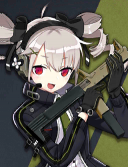 on T-doll commanding operations
on T-doll commanding operations
- ↑ Glory Day, AR K2
 K2
K2 


 demonstrates the capabilities and limitations of command protocol.
demonstrates the capabilities and limitations of command protocol.
- ↑ Chapter 7-4, AR M4A1
 M4A1
M4A1 


 mentions her advanced command module
mentions her advanced command module
- ↑ Chapter 7-6, SMG RO635
 RO635
RO635 


 mentions her basic command module
mentions her basic command module
- ↑ 20.0 20.1 Chapter 9-4, SMG RO635
 RO635
RO635 


 must sleep after overusing her command module
must sleep after overusing her command module
- ↑ 21.0 21.1 Deep Dive 3-4, SMG UMP9
 UMP9
UMP9 


 reaches her limits of using 404's fake command module outside of consciousness Level II
reaches her limits of using 404's fake command module outside of consciousness Level II
- ↑ Deep Dive 2-3, Audio File 6
- ↑ Deep Dive 3-3
- ↑ 24.0 24.1 SMG UMP45
 UMP45
UMP45 


 MOD Story 2
MOD Story 2
- ↑ RF Mosin-Nagant
 Mosin-Nagant
Mosin-Nagant 


 MOD2 story, Mosin comments on studying her weapon's history.
MOD2 story, Mosin comments on studying her weapon's history.
- ↑ 26.0 26.1 Singularity, 1A Stroke Dead Center 1
- ↑ Singularity 2-C Promotion I
- ↑ Chapter 9-1, SMG RO635
 RO635
RO635 


 disguises herself and AR M4 SOPMOD II
disguises herself and AR M4 SOPMOD II M4 SOPMOD II
M4 SOPMOD II 


 's signals to sneak past SF's foot troops, then trigger-happy SOP ruins everything
's signals to sneak past SF's foot troops, then trigger-happy SOP ruins everything
- ↑ Deep Dive 3-3, SMG UMP40
 UMP40
UMP40 


 and SMG UMP45
and SMG UMP45 UMP45
UMP45 


 swap to OGAS protocol to infiltrate Sangvis' main lab
swap to OGAS protocol to infiltrate Sangvis' main lab
- ↑ Deep Dive 2-4, SMG UMP45
 UMP45
UMP45 


 swaps to OGAS protocol to counter Parapluie
swaps to OGAS protocol to counter Parapluie
- ↑ Deep Dive E2-4, SMG UMP40
 UMP40
UMP40 


 mentioned her low-grade Fire-Control Core to SMG UMP45
mentioned her low-grade Fire-Control Core to SMG UMP45 UMP45
UMP45 



- ↑ Chapter 8-2, AR M16A1
 M16A1
M16A1 


 mentions that Sangvis Ringleaders sleep to clear their cache
mentions that Sangvis Ringleaders sleep to clear their cache
- ↑ Chapter 8-2E
- ↑ Singularity, Splinter Point I
- ↑ Deep Dive 1-1
- ↑ Deep Dive 2-4
- ↑ Continuum Turbulence, Chapter 1 Safe House
- ↑ AR M4 SOPMOD II
 M4 SOPMOD II
M4 SOPMOD II 


 MOD2 Story
MOD2 Story
- ↑ Chapter 5-5, AR M4 SOPMOD II
 M4 SOPMOD II
M4 SOPMOD II 


 questions why AR Team T-Dolls retain their emotions modules.
questions why AR Team T-Dolls retain their emotions modules.
- ↑ SMG UMP45
 UMP45
UMP45 


 MOD Story 1
MOD Story 1
- ↑ Isomer, Wolf and Owl I
- ↑ Far Side of the Sea part 1, AR MDR
 MDR
MDR 


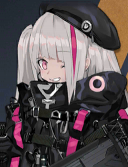 sneezes because she forgot to turn off the adequate module
sneezes because she forgot to turn off the adequate module
- ↑ 43.0 43.1 43.2 Bounty Feast, Hide Behind the Wall!
- ↑ Chapter 9-2E, SMG RO635
 RO635
RO635 


 uses her backup batteries to boost the signal emitter on AR M16A1
uses her backup batteries to boost the signal emitter on AR M16A1 M16A1
M16A1 


 's equipment case.
's equipment case.
- ↑ Continuum Turbulence, AR M4 SOPMOD II
 M4 SOPMOD II
M4 SOPMOD II 


 aims to retrieve a power unit to keep SMG RO635
aims to retrieve a power unit to keep SMG RO635 RO635
RO635 


 's neural core alive
's neural core alive
- ↑ Arctic Warfare 1-3, AR Team mentions the need for rations and their beneficial effects on morale
- ↑ Chapter 9-1E
- ↑ Chapter 9-4
- ↑ Continuum Turbulence, Chapter 1 Fortunate?
- ↑ Chapter 5-5, M16A1 mentions the fate of retired Griffin T-Dolls
- ↑ Bounty Feast, Stir the Ingredients
- ↑ 52.0 52.1 52.2 52.3 T-Doll character settings
- ↑ 2018's Sweet Oath event described G&K service T-Dolls were hired by wedding outfit tailors and served as clothing models
- ↑ SMG UMP45
 UMP45
UMP45 


 MOD1 story, UMP45 commenting on her depression being a factory default personality setting
MOD1 story, UMP45 commenting on her depression being a factory default personality setting
- ↑ 55.0 55.1 Continuum Turbulence E1, SMG Cx4 Storm
 Cx4 Storm
Cx4 Storm 


 's conversation with SOP II regarding her tobacco packaging collection
's conversation with SOP II regarding her tobacco packaging collection
- ↑ Singularity operation hour 1750, AR M4A1
 M4A1
M4A1 


 's behaviour change prior to and after undergoing modifications.
's behaviour change prior to and after undergoing modifications.
- ↑ 57.0 57.1 Commented by T-Doll's artist
- ↑ Chapter 4-2E, AR M4 SOPMOD II
 M4 SOPMOD II
M4 SOPMOD II 


 excitedly presents the latest piece of her collection to the Commander
excitedly presents the latest piece of her collection to the Commander
- ↑ 59.0 59.1 59.2 T-Doll quotes
- ↑ Glory Day event E1, where SMG TMP
 TMP
TMP 


 shows her interests and demonstrate ability in working with electronic gadgets
shows her interests and demonstrate ability in working with electronic gadgets
- ↑ Chapter 7-4E, the voice of SMG RO635
 RO635
RO635 


 is mumbly during her report because she has been drinking with AR M16A1
is mumbly during her report because she has been drinking with AR M16A1 M16A1
M16A1 



- ↑ Story described during event Hitoribocchi
- ↑ Bounty Feast, A Small Target
- ↑ Chapter 12-3
- ↑ Chapter 11-4E
- ↑ Chapters 10-2E and Continuum Turbulence 1-2





























